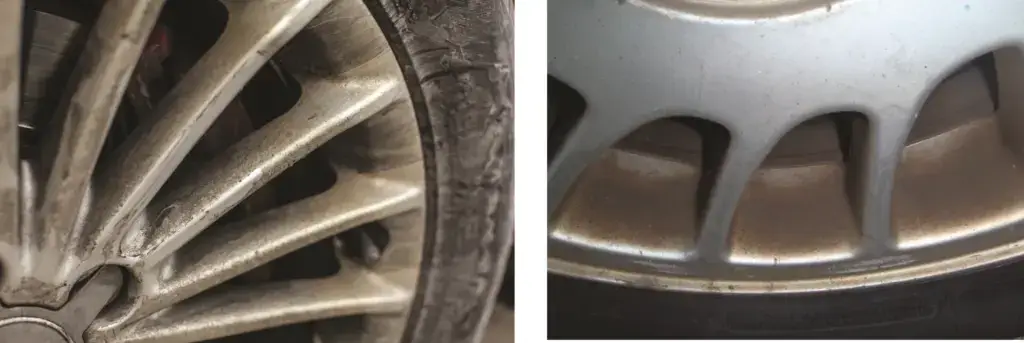Use a brake dust repellent to prevent wheel damage
When left on your wheels, brake dust etches into the surface
Cleaning your wheels regularly and applying a brake dust repellent or wax can prevent etching on your wheels
How brake dust etches your wheels
Georgia Tech’s School of Earth & Atmospheric Sciences has found that acidic sulfate found normally in the air can mix with the metals in brake dust, causing it to slowly become soluble and acidic. All you need is water to turn it into a perfect etching compound that ruins the look of your wheels.
The longer the dust it sits on your wheels, the more it etches into the clear coat.
And, it turns out, it’s not just your brake dust that causes the problem. Brake dust is everywhere along the road surface. It settles on the road and traffic kicks it up into a cloud above the surface (see below).
Using a brake dust repellent and regular cleaning is critical to maintain the look of your wheels
Purchase protective waxes to slow down the etching process and clean them often. Clean your wheels with a wheel cleaning product. Let them dry. Then apply a high quality brake dust repellent product. If you can’t find one, use a polymer based car “wax,” or a ceramic wax.
But brake dust is a health hazard so wear an N95 mask while cleaning your wheels
Scientists have always thought that acidic sulfate was a health hazard. But there’s not enough acidic sulfate in the air to burn the lining of your lungs. So they’ve been stumped as to how the damage occurs. A recent study by the National Science Foundation and the U.S. Environmental Protection Agency found the smoking gun.
When acidic sulfate mixes with the metals in brake dust, the oxidative stress causes the mixture to become soluble. Once inhaled, the combination comes in contact with bodily fluid and the highly acidic mixture burns the lungs.
How did researchers find the link to environmental brake dust?
From the Georgia Institute of Technology —
“The researchers collected samples of ambient particulate matter in two locations in Atlanta — one near a major interstate highway and another urban site 420 meters away from the roadway. They analyzed the chemical content, size distribution and acidity of the samples.
A significant amount of the ambient sulfate found was similar in size to the metal particles, suggesting that the ambient sulfate and metals were mixed within individual particles, which over hours or days would allow the acidic sulfate to convert the metal into a soluble form
To quantify just how dangerous the aerosol could be, the researchers developed a high throughput analytical system for a chemical assay — called oxidative potential — that simulates the toxic response that such a mix would have on cellular organisms. This instrument was used to generate large data sets on ambient aerosol oxidative potential, which when utilized in an earlier epidemiological study, researchers at Georgia Tech and Emory University found that the chemical assay was statistically associated with hospital admissions in Atlanta for asthma and wheezing.
In the new study, the researchers observed that the peak toxicity indicated by the assay was closely correlated to those particles that contained the largest amount of soluble metals, which occurred only when metallic particles mixed with highly acidic sulfate.
“That’s the smoking gun,” Nenes said. “The sulfate essentially dissolves those metals; when you breathe in those particles, the metals could be absorbed directly into the blood stream and cause problems throughout the body. For the first time, a mechanism emerges to explain why small amounts of acidic sulfate can adversely affect health.”
While the sample taken from the testing site located farther away from the highway had less particulate metal, there was still enough to cause an increase in the oxidative potential, showing that roadway pollution could travel through the air and potentially cause problems in surrounding areas as well.”
©, 2023 Rick Muscoplat
Posted on by Rick Muscoplat

